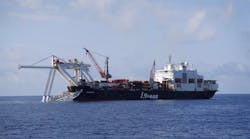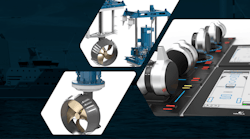In recent years, the focus of the offshore industry has been directed towards deepwater developments, however it is essential that the importance of shallow water technology is not neglected. To address greater technology needs in shallow water, the pipelay barge Arwana was developed by PT. Komaritim, the Indonesian subsidiary of Stolt Comex Seaway. The Arwana is the first shallow water pipelay barge in built in Indonesia and registered under the Indonesian flag. The vessel is ideally suited to working in areas such as shallow water offshore sites, shore approaches, swamps and river crossings.
The vessel, which was built in 1998, has an overall length of 70.1 meters, a breadth of 21.3 meters with a minimum draft of only 1 meter. The Arwana has been designed with a specially reinforced hull, which allows the vessel to be grounded on the seabed. This facility, which significantly increases the productivity of the pipelay operations, allows the vessel to remain on location during low tide, being ready to commence pipelay once the tide starts to turn. The Arwana is fitted with the latest safety and firefighting equipment, including heat detection system, fire pumps, hospital, and life saving appliances.
The vessel is a conventional pipelay barge held on station and maneuvered using an 8-point mooring system, and equipped with 4.5-ton anchors. The Arwana uses the S-Lay method with a stinger for pipelay and is capable of laying pipelines up to 52 in. in diameter. The pipe joints are stored on board the vessel and loaded into the firing line mounted on the deck of the vessel using a 250-ton crawler crane. A system of rollers supports the pipe as it moves down the firing line and onto the stinger. There are three welding stations on the firing line for welding of the pipeline together with a radiography and field joint coating station.
Welding line
The pipelay system is equipped with a 25-ton tensioner for controlling the tension in the pipe to prevent buckling during laying. SAS Gouda in The Netherlands, which designs and fabricates specialized offshore equipment for pipe and cable laying systems, supplied the tensioner. The tension is applied at a continuous level, through the tensioner clamping to the pipe with a set of tracks, which are powered to pay in or out to compensate for barge motion and maintain the required tension in the pipeline.
As with all pipelay barges, the Arwana is equipped with an abandonment and recovery (A&R) system, for the situations where sea conditions are sufficiently high to stop the laying operations and the pipeline can be temporarily lowered to the seabed. This procedure starts with the transfer of tension from the tensioner system to the A&R winch. During this critical operation it is essential that the required level of tension is maintained within the pipe. In order to perform this operation safely, the pipelay system is equipped with a synchronization system which automatically controls the tension transfer between the decreasing tension in the pipe tensioner and the increasing tension in the A&R winch.
Since coming into service in 1999, the Arwana has performed a number of pipelay projects off the East Kalimantan region of Indonesia. These projects included the construction of a shore approach for two 24-in. diameter pipes each laid out to 5 km offshore, and a series of river crossings for a 42-in. diameter pipeline. Currently, the Arwana is working for Total Indonesie as part of the Phase 6/EPSC 2 of the Tunu Field Development off East Kalimantan. This project, which was scheduled to be completed at the end of 1999, includes the installation of a series of pipelines in both swamp and open water conditions with diameters ranging from 8 in. to 24 in.




